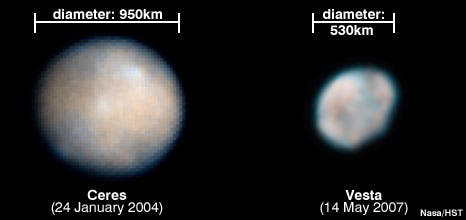It’s one asteroid down and one to go, for NASA’s Dawn spacecraft. After spending a year studying the Vesta asteroid and retrieving valuable information to Earth, Dawn is now ready to head for its next destination: Ceres.
A different world
Scientists expect Ceres to be very different from Vesta. Ceres is considered to be the largest asteroid in our solar system, accounting for about a third of all the mass in the asteroid belt; in fact, it is a dwarf planet (the only one in the inner system), discovered more than 200 years ago, in 1801 – however, it was thought to be a full sized planet at the moment.
Ceres highlights a rocky inner core, and an icy mantle, and many believe it might hold a liquid ocean beneath the icy surface. The 100 km mantle has more freshwater than the Earth, and while exobiologists haven’t speculated on this matter as much as with Europa, for example, there is a possibility of life existing in the liquid water – if there is such a thing on Ceres.
Leaving Vesta
Vesta is a large asteroid too, the second largest one in our solar system, after Ceres, of course, with a mean diameter of about 525 kilometers; among its notable features, there lies a mountain about three times taller than Mount Everest. After spending one year on Vesta, Dawn slowly powered up its ion thrusters, slowly spiraling away from it after it can finally break free from the gravitational field. However, since its antenna has been pointed away from Earth, researchers have to wait until Wednesday to know if everything went according to plan – pretty much like with the ‘seven minutes of terror‘, for Curiosity. Still, it’s not the same thing.
“It’s not a sudden event. There’s no whiplash-inducing maneuver. There’s no tension, no anxiety,” said chief engineer Marc Rayman of the NASA Jet Propulsion Laboratory, which manages the $466 million mission. “It’s all very gentle and very graceful.”
A new Dawn
The Dawn shuttle is about to reach a historical landmark, if it succeeds in its three year trip: it will become the first shuttle to ‘hook up’ with two different celestial bodies – in a bid to learn more about our solar system’s evolution, and the asteroids themselves.
During its one year stay at Vesta, Dawn was quite busy, using its cameras, infrared spectrometer, gamma ray and neutron detector to explore the asteroid from different altitudes, getting as close as 209 kilometers from its surface; and it wasn’t in vain: Dawn revealed quite a few surprises.
Scientists have long known Vesta is scarred at its southern pole, likely from an impact with a smaller asteroid, but a closer inspection revealed Vesta has another scar pretty close to the first one – evidence that it has been hit twice by asteroids in the last 2 billion years. The collision threw shrapnel like pieces of rock into outer space, some of them actually landing on Earth as meteorites.
Asteroids – friend and foe
Asteroids have been given a lot of attention lately – for varied reasons. There is of course the always present fear that some naughty asteroid might head for our planet and whack us to oblivion – though now NASA keeps track of virtually all near-Earth asteroids, and even with today’s technology, there are ways to deflect an asteroid.
President Barack Obama canceled a return to the moon in favor of landing astronauts on a yet-to-be-selected asteroid as a stepping stone to Mars, and perhaps even more interesting – a number of tech billionaires are planning to mine asteroids for rare metals (gold, platinum, iridium, etc).
Researchers expect a much changed story on Ceres. Unlike the rocky Vesta, the nearly spherical Ceres has a dusty surface with an icy interior.
“Almost everything we see at Ceres will be a surprise and totally different from Vesta,” Russell said.
Via NASA’s Jet Propulsion Laboratory






